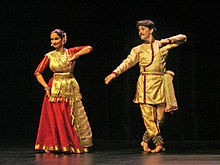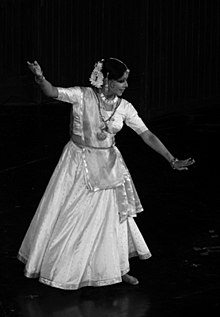Kathak
Kathak is an Indian dance style that is particularly common in northern India, Punjab and the state of Uttar Pradesh .
history
It developed since the 13th century through wandering bards and storytellers who came from castes whose profession it was to sing religious songs ( bhajan or ghazel ) and to accompany them with dance. Most of these songs dealt with the life of Vishnu and Krishna , but as a result of the Muslim rule of the Mughals , the themes and music of the Kathak changed fundamentally, as this art form was now mainly performed in courts, where local artists met Persian and Arab musicians. In addition to the religious, secular topics were also taken up. Hindu poets such as Jayadeva , Kabir , Tulsidas and Chaitanya, who preached Vishnuism , provided templates for the dances .
Since the 18th century there have been several places where the Kathak has been further developed. The Jaipur - Gharana in Vrindavan , which is characterized by rapid footwork and rhythm distinguishes the Lucknow -Gharana, which is characterized by lyrical elements and the Banares-Gharana founded by Janaki Prasad extending from Varanasi to Lahore spread and their style by slow Elements and footwork to chanted phonetic syllables.
Nowadays there are many dance centers and colleges in India teaching Kathak.
Performance practice
Usually a singer, accompanied by a tabla or pakhawaj , calls Ganesha at the beginning of a Kathak performance in a homage ceremony ( purvaranga ) to ask for the event to go well. Then the stage is worshiped with flowers and incense. Kathak is danced by women and men, often as a solo dance. In contrast to some South Indian dance styles, the dance is not performed on the very edge of the sole of the foot, but on the flat foot and toes. The dancers wear up to 150 bells and bells on their ankles, which underline the footwork, which is particularly important in Kathak. A lot of turns, jumps and pirouettes are also part of the dance, whereby the position is predominantly vertical. The narrative Abhinaya parts are almost exclusively carried out with hands, fingers and arms in an economical facial expression, whereby the basic position is often calm with closed feet or sitting. After the opening invocation, shorter dances follow, the sequence of which is not fixed. There are up to a hundred more dance-like pieces such as the tukras and paranas, in which the dancer reacts to the call of hard phonetic syllables, but also dances to religious poems and dances to mystical love poems.
The gats depict episodes from the life of Krishna, with the dancers representing multiple characters. The folkloric Ras lila is performed in groups and tells of Krishna, Radha and the Gopis (cowherd women).
There is a similarity between Kathak and the dances in the Alibuxi khyal folk theater of Rajasthan.
literature
- Fabrizia Baldissera, Axel Michaels : The Indian dance. DuMont Buchverlag, Cologne 1988, ISBN 3-7701-1789-1
- Nicole Manon Lehmann: Sama and the 'beauty' in the Kathak. North Indian dance and its constituent concepts using the example of Lucknow-gharana. LIT Verlag, Münster 2010, ISBN 978-3-643-10252-2
- Margaret Walker: Courtesans and Choreographers: The (Re) Placement of Women in the History of Kathak Dance. In: Pallabi Chakravorty, Nilanjana Gupta (Ed.): Dance Matters: Performing India. Routledge, New Delhi 2010, pp. 279-300
Web links
Individual evidence
- ^ Darius L. Swann: The Folk-Popular Traditions. Introduction. In: Farley P. Richmond, Darius L. Swann, Phillip B. Zarrilli (Eds.): Indian Theater. Traditions of Performance. University of Hawaii Press, Honolulu 1990, p. 241


